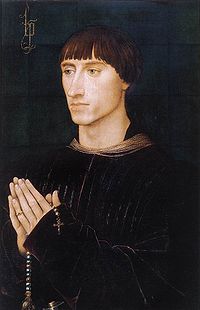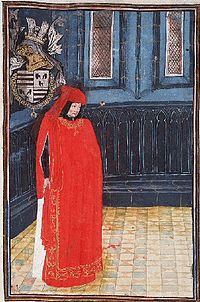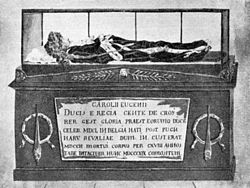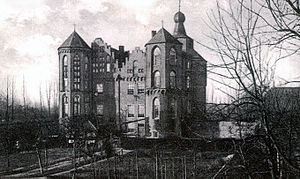- House of Croÿ
-
 Arms of Philippe I de Croÿ, detail of Rogier's diptych (ca. 1460)
Arms of Philippe I de Croÿ, detail of Rogier's diptych (ca. 1460)
The House of Croÿ (French pronunciation: [kʁui][1]) is an international family of European mediatized nobility which held a seat in the Imperial Diet from 1486, and was elevated to the rank of Imperial Princes in 1594. In 1913 the family had branches in Belgium, France and Prussia[2]
This dynastic house, which originally adopted its name from the Château de Croÿ in what is now Belgium, claimed descent from the Hungarian[2] Prince Marc[3] who allegedly settled in France in 1147, where he married an heiress to the barony of Croÿ. The Croÿ family rose to prominence under the Dukes of Burgundy. Later they became actively involved in the complex politics of France, Spain, Austria, and the Low Countries.
Among the more illustrious members of the House of Croÿ were two bishops-dukes of Cambrai; two cardinals (one being also the Archbishop of Toledo and another being the Archbishop of Rouen); five bishops (those of Therouanne, Tournai, Cammin, Arras, and Ypres);one prime minister of Philipe the Good, One Finance Minister, prime minister, Chief Admiral, godfather and tutor of the emperor Charles V (himself godfather of other Croÿ). one Prince of Masovia; one Grand-Bouteiller, one Grand-Maitre and one Marshal of France; one Grand Equerry of the King of Spain; several imperial field marshals and twenty generals; 4 Finance Ministers of the Netherlands; a couple of governors of the Netherlands and Belgium ; one Russian Field-Marshal; numerous Ministers, Ambassadors and Senators in France, Austria, Belgium; and a record of thirty two knights of the Order of the Golden Fleece.
Contents
The Croÿs of Burgundy
Jean I de Croÿ was responsible for the ascendancy of his family to a position of supreme power in medieval Burgundy. He served Philip the Bold and his son John the Fearless in the capacity of councillor and chamberlain. In 1384 he married a wealthy heiress, Marie de Craon, successfully suing her first husband's family upon her death. In 1397, Jean acquired the lordship of Chimay, which was to become a core dominion of the Croÿ family. Four years later, he was appointed Governor of Artois and led the ducal armies against the rebellious citizens of Liege. He was recorded as the Grand Bouteiller of the King of France in 1412 when he laid siege to Bourges. The following year, Isabeau of Bavaria had him apprehended and incarcerated in the castle of Montlhéry, from where he escaped. Jean, together with two of his sons, was killed in the Battle of Agincourt on October 25, 1415.
Antoine I le Grand, Jean I's eldest surviving son and heir, was a key figure in 15th-century French politics. Securing for himself the post of Governor General of the Netherlands and Luxembourg, he presided over the pro-French party at the court of Philip the Good and was one of the judges at the trial for treason in 1458 of Duke of Alençon. Like his father, he led French and Burgundian armies against Liege and distinguished himself at the Battle of Brouwershaven fighting against the English. While on a mission to the court of Duke of Berry, he was implicated in the assassination of the Duke of Orléans and as a consequence suffered torture in the Château de Blois.
Having extricated himself from this predicament, Antoine used his power to expand his family's possessions: in 1429 he obtained the lordship and peerage of Le Rœulx; three years later he married a Princess of Lorraine, who brought Arschot to his family as her dowry; in 1446 he purchased the Château of Montcornet and completely rebuilt it. In 1438 he acquired the castle of Porcien and was made Count of Porcéan and Guînes by Charles VII in 1455. A year earlier, he had married his daughter to Count Louis I of Pfalz-Zweibrücken in order to increase his influence in the orbit of the Holy Roman Empire.
With Charles the Bold, the future Duke of Burgundy, he was at loggerheads, especially after they had clashed over the inheritance of Jeanne d'Harcourt, Countess of Namur. Upon Charles's accession, Antoine was accused of plotting with astrologers to bring about the Duke's downfall and was compelled to flee to France. In France he took part in the coronation of Louis XI and was chosen as a godfather to the future Louis XII. It was not until the age of 83 that he reconciled himself with Charles and was allowed to reclaim his properties in Burgundy. He died either in 1475 or 1477 and was interred in Porcien.
Agnes de Croÿ was his sister and the mistress of Duke Jean the Fearless, by whom she had a natural son, the future Bishop of Cambrai and Archbishop of Trier. Several noble families of Belgium and the Netherlands are descended from this prelate's eleven illegitimate children.
The lines of Croÿ-Arschot-Havré and Croÿ-Roeulx stem from Antoine's two sons, Philippe I and Jean III, while his younger brother, Jean II, was the progenitor of the only extant line of the family, that of Croÿ-Solre. All three lines demonstrate a complex pattern of intermarriage, so that estates and titles would stay within the family as long as possible.
The line of Croÿ-Aerschot
 Portrait of Philippe I de Croÿ, by Rogier van der Weyden
Portrait of Philippe I de Croÿ, by Rogier van der Weyden
Antoine was succeeded as Count of Porcéan by his eldest son, Philippe I de Croÿ, Governor of Luxembourg and Ligny. Philippe I de Croÿ was raised together with Charles the Bold, who arranged Philippe's marriage to Jacqueline of Luxembourg in 1455. The bride's father was extremely against the alliance and attempted to win his daughter back by force, but the Count of Porcéan closed the borders of Luxembourg and announced that the marriage had been consummated. In 1471 Philippe defected to the King of France with 600 knights but returned to Burgundy to fight for Charles during the Battle of Nancy. During the battle he was taken prisoner. Following Charles's death, Philippe de Croÿ helped arrange the betrothal of his heiress Marie with Emperor Maximilian I. Towards the end of his life, he was employed by the Emperor as Governor of Valenciennes, Lieutenant General of Liege, and Captain General of Hainaut. Philippe commissioned a remarkable church in Château-Porcien, in which he was buried upon his death in 1511.
Among Philippe's sons, Antoine, Bishop of Thérouanne, predeceased his father and lies buried in Cyprus. More notable was Guillaume de Croÿ (1458-1521), (whose name is translated as Guillermo de Xebres in Spanish documents). As a tutor to Carlos I of Spain (afterwards emperor Charles V), Guillaume became the power behind the Spanish throne during his pupil's minority. Thus obtaining for himself the titles of Marquess of Aerschot and Duke of Soria and Archi. The Spanish aristocracy detested him as a foreigner, accusing him of pillaging the treasury and other irregularities, causing a wave of civil unrest to spread through Castile. Guillaume went to attend the famous Diet of Worms, where he was poisoned on 28 May 1521, apparently by German nobles afraid of his influence on imperial politics.
Guillaume's nephew and namesake, Guillaume III de Croÿ (1498-1521), was educated in Louvain with Juan Luís Vives, a great philosopher of the time. As it appeared unlikely that he would succeed to the lands of his grandfather, Philippe I, he was destined to the church. Family interests ensured his rapid promotion: he was elected Bishop of Cambrai at the age of 17. Within a year, Charles V bestowed upon his young Burgundian friend the archbishopric of Toledo, making him a cardinal and Primate of Spain. This unprecedented move brought Spain to the brink of a civil war. Guillaume accompanied his uncle and Charles to Worms, where on January 6 he died aged 22, following a fall from his horse. His tomb is in the Celestin monastery of Louvain, founded by his father.
Guillaume III's elder brother, Philippe II de Croÿ (1496 - 1549), succeeded to the County of Porcéan upon his father's death in 1514. Like his predecessors, he was Governor of Hainault and Senior Knight of the Order of the Golden Fleece, but it is as Charles V's general that he is best remembered. In 1533 Charles V created Philippe ("our cousin", as he styled him) Duke of Soria and Archi and Grandee of Spain First Class. Earlier, he had become Marquess of Renty and exchanged the lordship of Longwy in Normandy for that of Havré, which his descendants would develop as a family nest. His first wife was a cousin, Anne de Croÿ, Princess of Chimay. She died in 1539, and nine years later Philippe married Anna of Lorraine. He left offspring by both marriages.
Philippe II's eldest son, Charles I de Croÿ (1522-51), inherited the Principality of Chimay from his mother and succeeded to the Duchy of Aerschot upon his father's death. He was assassinated in Quievrain two years later, leaving no children by his marriage to Louise of Lorraine-Guise. Thereupon Chimay and Aerschot passed to Philippe II's second son, Philippe III.
Philipe de Croÿ, Duke of Arschot (1526-1595), was made 216th Knight of the Order of the Golden Fleece by Philip II of Spain. In 1567 his cousin Antoine III de Croÿ, 1st Prince of Porcéan died without issue by his marriage to Catherine of Cleves, and the Principality of Porcéan devolved upon Philippe. His devotion to the Roman Catholic Church, which he expressed by showing his delight at the Massacre of St. Bartholomew, led Philip II to regard him with great favor. He was appointed governor of the citadel of Antwerp but defected to the other side before long. Jealous of William the Silent's influence, he was then the head of the party which induced the Archduke Matthias (afterwards emperor) to undertake the sovereignty of the Netherlands, and soon afterwards was appointed Governor-General of Flanders by the state council. A strong party, including the burghers of Ghent, distrusted the new governor; and Arschot, who was taken prisoner during a riot at Ghent, was only released on promising to resign his office. He then sought to regain the favor of Philip of Spain, and having been pardoned by the king in 1580 again shared in the government of the Netherlands; but he refused to serve under the count of Fuentes when he became governor-general in 1594, and retired to Venice, where he died in December 1595.
Philippe III was succeeded by his only son, Charles II de Croÿ (1560-1612), who was created Duke of Croÿ by Henry IV of France in 1598. As Charles was childless, the duchy of Arschot passed to his sister Anna de Croÿ, who had married Karl, Prince of Arenberg, thus bringing Aarschot to the House of Arenberg. Another sister, Marguerite, inherited the lordships of Halewyn and Commines, which passed to her husband, Wratislaw, Count of Fürstenberg.
The line of Croÿ-Havré
First line
Charles Philippe de Croÿ (1549-1613) was the eldest son of Philippe II by his second wife, Anna of Lorraine. A successful imperial general, he was created Prince of the Holy Roman Empire in 1594. It was the first time when a simple baron was admitted among Princes of the Empire.
Charles Alexandre de Croÿ, Marquess of Havré (1581-1624) was the son of the preceding. He inherited the title of Prince of Croÿ from his father, that of Count of Fontenoy from his mother, Diane de Dompmartin, and that of Duke of Croÿ (in the French peerage) - from his childless cousin and brother-in-law, Charles II. He served as a hereditary marshal of the Holy Empire in the Battle of Prague, and advised Archduke Albert of Austria, Governor of Netherlands in the capacity of his chamberlain. Philip III of Spain made him the Superintendent of Finances and a Grandee of Spain. His second wife, Countess Genevieve d'Urfe, was a great beauty notorious for her many liaisons. When Charles Alexandre was shot dead in his palace at Brussels on November 5, 1624, French courtiers put the blame upon Genevieve and her reputed lover, the Marquess of Spinola. One innocent man was condemned on that account and was immured in a fortress until a true culprit admitted his guilt to a confessor 32 years later. Charles Alexandre's precious reminiscences had not been published until 1845.
Charles Alexandre's nephew, Ernst Bogislaw von Croÿ (1620-1684), inherited both princely and ducal titles of Croÿ when he was just 4. As his father died a month after his birth, Ernst Bogislaw was brought up by his mother, Princess Anna von Croy, also known as Anna of Pomerania, in her native land, where he was styled Prince of Masovia and Prince of Neugarten. Although he was destined to the church and received the see of Cammin in due time, Ernst Bogislaw also had illegitimate issue by several mistresses. He died in Königsberg at the age of 63 and was buried in Stolp (now Słupsk) Castle.
Second line
Marie Claire de Croÿ (1605-1664) was Charles Alexandre's only daughter by his marriage to Princess Yolande of Ligne. As was expected, she married two of her distant cousins, Charles Philippe de Croÿ, Marquess of Renty (in 1627) and then his brother Philippe Francois de Croÿ, Count of Solre (in 1643), in order to preclude the family estates from passing to another family. At the time of her first marriage, Philip III of Spain raised her marquessate of Havré to a dukedom, with her as the first duchess.
By her first marriage, she had two children - Philippe Eugene de Croÿ, Bishop of Valencia and Marie Ferdinande, Marchioness of Renty, the wife of Count Egmond. Her only son by the second marriage, Ferdinand Francois Joseph de Croÿ-Solre, succeeded to the ducal title. Among his children, Charles Antoine Joseph, the 4th Duke of Havré, was killed at Saragossa in 1710; Marie Therese Josephe left children by her marriage to Landgrave Philip of Hesse-Darmstadt; and Jean-Baptiste de Croÿ, the 5th Duke, left issue by his marriage to Marie Anne Césarine Lante Montefeltro della Rovere, of the House of della Rovere (daughter of Antonio Lante Montefeltro della Rovere). This line came to an end in 1839, when the 7th Duke of Havré and Croÿ died in Paris aged 95, having outlived all of his sons. His daughter and heiress married a distant cousin, Emmanuel de Croÿ-Solre, who succeeded to the estates and titles.
The 7th Duke's sister, Louise Elisabeth de Croÿ-Havré (1749-1832), is best known for her book of memoirs on the French Revolution and the years of emigration that followed. A close friend of Queen Marie Antoinette, she was appointed by her to the vacant post of Royal Governess, with particular care for the future Louis XVII. During the revolution, she was incarcerated with her own daughter and already prepared to meet a guillotine, when a mysterious gentleman smuggled them out of the prison. After one of her pupils ascended the throne as Charles X he created her a hereditary duchess of Tourzel in her own right. Louise Elisabeth de Croÿ, 1st Duchess of Tourzel died in the Château de Groussay on May 15, 1832.
The line of Croÿ-Roeulx
The line of Counts of Roeulx descends from Jean III de Croÿ (1436-1505), the second son of Antoine le Grand and younger brother of Philippe I. Jean III's grandson, Adrien de Croÿ, 1st Count of Roeulx, served as Governor of Flanders and Artois before his death in a combat in 1553. His granddaughter is remembered as La Belle Franchine, the beautiful mistress of Alessandro Farnese.
In 1609, the senior line of the Counts of Roeulx went extinct, and the county passed to a cadet line, represented by Eustache de Croÿ (1608-73), Governor of Lille and Douai. Eustache's son, Ferdinand Gaston Lamoral de Croÿ, unexpectedly succeeded to the Duchy of Croÿ in 1684, when the most senior member of the house, Ernst Bogislaw von Croÿ, had died in Königsberg. After Ferdinand's grandson, 6th Duke of Croÿ, died childless at Le Roeulx in 1767, the line of Croÿ-Roeulx expired and the chateau du Roeulx together with the ducal title passed to the line of Croÿ-Solre (see below).
Probably the most illustrious member of the Croÿ-Roeulx branch was Eustache's nephew, Charles Eugène de Croÿ (1651-1702). He participated in the Battle of Lund (1676) against the Swedes before succeeding to his father's title of Prince of Croÿ-Millendonck in 1681. Charles Eugene fought with success in the Imperial Austrian Army against the Turks and participated in both the liberation of Vienna in 1683 and the attack on Belgrade in 1690. He was promoted Imperial Field Marshal for his vital services to the Austrian crown. In 1697 he entered the Russian service and was put in charge of Peter I's forces fighting in Livonia during the initial stages of the Great Northern War. After suffering a humiliating defeat in the Battle of Narva on 20 November 1700, Charles Eugene was taken prisoner by the Swedes and died imprisoned at their fortress of Reval on January 30, 1702. On demand of his creditors, his body was not buried for more than a century {190 years-until 1897}, and, when mummified, was exhibited in a glass coffin as a curiosity, with fees paid by tourists as a price of admission used to settle his debts.
The line of Croÿ-Solre
Origins
The only line of the House of Croÿ extant today, that of Croÿ-Solre, descends from Antoine le Grand's younger brother, Jean II de Croÿ (1395-1473), who governed Hainaut and Namur in the name of the Dukes of Burgundy. His dominions were centred on the town of Chimay, of which he became the first count. In 1430, he was made one of the very first Knights of the Order of the Golden Fleece.
Jean II's grandson, Count Charles de Croÿ-Chimay (1455-1527), made a name for himself in the Battle of Guinegate in 1479. He succeeded to the county of Chimay in 1482 and to the possessions of his mother, a Countess of Mors-Saarwerden, several years later. In April 1486 Emperor Maximilian elevated the county of Chimay to a principality and admitted Charles de Croÿ into the Imperial Diet. In 1500, Charles was summoned to take part in the baptism of the future emperor Charles V, during whose minority he served as one of the governors. The Prince of Chimay had many children by his wife, Louise d'Albret, sister of Jean d'Albret, King of Navarre. Only two daughters reached the age of seniority, with Anne inheriting Chimay and Marguerite inheriting Wavrin. The former married a cousin, Philippe II de Croÿ, Duke of Arschot (see above), and their children succeeded to the principality of Chimay.
Jacques III de Croÿ-Sempy (1508-1587) was Jean II's great grandson and Charles de Chimay's nephew. It was through his mother, Louise of Luxembourg, that he succeeded to the Château of Fontaine-l'Eveque in 1529, later obtaining more lands as a dowry for his three marriages. His last wife, Yolande de Lannoy, brought the manors of Molembais, Solre, and Tourcoing to the House of Croÿ. Their son Philippe was the first to style himself Count of Solre. He died in Bohemia in 1612, leaving two daughters and four sons, of whom the eldest succeeded as the 2nd Count of Solre. A younger son married the 1st Duchess of Havré, giving birth to the second line of Croÿ-Havré, which failed in 1839 (see above).
Modern times
 Anne Emmanuel, 8th Duke of Croÿ
Anne Emmanuel, 8th Duke of Croÿ
Towards the end of the 18th century, as other branches of the family were coming to an end, the line of Croÿ-Solre accumulated a number of their titles and possessions. During the French Revolution, Anne Emmanuel de Croÿ, 8th Duke of Croÿ (1743-1803) moved his seat from Le Rouelx to the Westphalian town of Dülmen, formerly a possession of his wife, a Princess of Salm-Kyrburg. Among his sons, Prince Gustave Maximilien Juste of Croÿ (1772-1844) rose to become a Cardinal and Archbishop of Rouen.
Another son, Auguste Louis Philippe Emmanuel de Croÿ, 9th Duke of Croÿ, better known as Le Bel Auguste (1765-1822), was mediatized upon the demise of the Holy Roman Empire in his capacity of the sovereign prince of Dülmen. When the Bourbons were restored to the throne of France, Auguste was made a Peer of France. He joined his relatives in conducting a lawsuit against a certain Claude Francois Crouy-Chanel, who had usurped the name, titles and arms of the House of Croÿ. From three of Auguste's sons - Alfred, Ferdinand, and Philipp Franz - descend the three extant branches of the House of Croÿ, residing in Germany and France.
 The only wild herd of Dülmen ponies extant today, owned by the Dukes of Croÿ
The only wild herd of Dülmen ponies extant today, owned by the Dukes of Croÿ
On 27 October, 1913, Karl Rudolf, 13th Duke of Croÿ, married Nancy Leishman, daughter of Pittsburgh industrialist John George Alexander Leishman, United States Ambassador to Germany and former president of Carnegie Steel. In 1974 Karl Rudolf died and was succeeded by his son Carl (d. 14 June 2011), 14th Duke of Croÿ; Carl was married to Princess Gabriele of Bavaria, daughter of Crown Prince Rupprecht of Bavaria. Their eldest son, Rudolf, the 15th and current Duke of Croÿ, is married to Alexandra Miloradovich, of the Trubetskoy princely lineage; they have six children.
See also
- Jean I de Croÿ (1365-1415)
- Antoine de Croy, Comte de Porcéan (1385-1475)
- Jean II de Croÿ (1390-1473)
- Philippe I de Croÿ (1435-1511)
- William de Croÿ, advisor to Emperor Charles V (1458-1521)
- William de Croÿ (archbishop) (1497–1521)
- Philippe II de Croÿ (1496-1549)
- Charles II de Croÿ (1522-1551)
- Philipe de Croÿ, Duke of Arschot (1526-1595)
- Charles III de Croÿ (1560-1612)
- Ernst Bogislaw von Croÿ (1620-1684)
- Charles Eugène de Croÿ (1651-1702).
- Louise Elisabeth de Croÿ-Havré (1749-1832)
- Gustave de Croÿ-Solre (1772-1844)
- Princess Isabella of Croÿ (1856-1931), married Archduke Friedrich, Duke of Teschen
References
- ^ http://www.scribd.com/doc/46517148/%C2%AB%C2%A0Les-Dames-galantes%C2%A0%C2%BB-au-fil-des-mots-012
- ^ a b "Duchess of Croy snubbed officially" (PDF). The New York Times. 1913-12-11. http://query.nytimes.com/mem/archive-free/pdf?_r=1&res=9D0DE5D9103FE633A25752C1A9649D946296D6CF&oref=slogin. Retrieved 2008-03-28.
- ^ "Croy-Leishman match a romance" (PDF). The New York Times. 1913-04-20. http://query.nytimes.com/mem/archive-free/pdf?res=9B0DE1D81139E633A25753C2A9629C946296D6CF. Retrieved 2008-03-28.
Source
Georges Martin. Histoire et Généalogie Maison de Croÿ. HGMC, 2002.
Coat of Arms
External links
Categories:- House of Croÿ
- Belgian nobility
- French nobility
- Westphalian nobility
- Prussian nobility
- German people of Belgian descent
Wikimedia Foundation. 2010.














